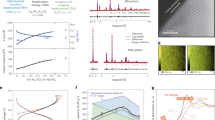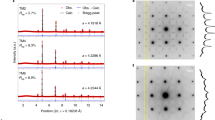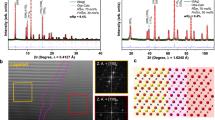Abstract
The rapid market growth of rechargeable batteries requires electrode materials that combine high power and energy and are made from earth-abundant elements. Here we show that combining a partial spinel-like cation order and substantial lithium excess enables both dense and fast energy storage. Cation overstoichiometry and the resulting partial order is used to eliminate the phase transitions typical of ordered spinels and enable a larger practical capacity, while lithium excess is synergistically used with fluorine substitution to create a high lithium mobility. With this strategy, we achieved specific energies greater than 1,100 Wh kg–1 and discharge rates up to 20 A g–1. Remarkably, the cathode materials thus obtained from inexpensive manganese present a rare case wherein an excellent rate capability coexists with a reversible oxygen redox activity. Our work shows the potential for designing cathode materials in the vast space between fully ordered and disordered compounds.
This is a preview of subscription content, access via your institution
Access options
Access Nature and 54 other Nature Portfolio journals
Get Nature+, our best-value online-access subscription
$29.99 / 30 days
cancel any time
Subscribe to this journal
Receive 12 digital issues and online access to articles
$119.00 per year
only $9.92 per issue
Buy this article
- Purchase on Springer Link
- Instant access to full article PDF
Prices may be subject to local taxes which are calculated during checkout





Similar content being viewed by others
Data availability
The datasets generated and analysed during the current study are available from the corresponding author upon reasonable request.
References
Xu, B., Qian, D., Wang, Z. & Meng, Y. S. Recent progress in cathode materials research for advanced lithium ion batteries. Mat. Sci. Eng. R 73, 51–65 (2012).
Olivetti, E. A., Ceder, G., Gaustad, G. G. & Fu, X. Lithium-ion battery supply chain considerations: analysis of potential bottlenecks in critical metals. Joule 1, 229–243 (2017).
Thackeray, M. M. et al. Li2MnO3-stabilized LiMO2 (M = Mn, Ni, Co) electrodes for lithium-ion batteries. J. Mater. Chem. 17, 3112–3125 (2007).
Yu, X. et al. Understanding the rate capability of high‐energy‐density Li‐rich layered Li1.2Ni0.15Co0.1Mn0.55O2 cathode materials. Adv. Energy Mater. 4, 1300950 (2014).
Lee, J. et al. Reversible Mn2+/Mn4+ double redox in lithium-excess cathode materials. Nature 556, 185–190 (2018).
Yabuuchi, N. et al. High-capacity electrode materials for rechargeable lithium batteries: Li3NbO4-based system with cation-disordered rocksalt structure. Proc. Natl Acad. Sci. USA 112, 7650–7655 (2015).
Lee, J. et al. A new class of high capacity cation-disordered oxides for rechargeable lithium batteries: Li–Ni–Ti–Mo oxides. Energy Environ. Sci. 8, 3255–3265 (2015).
Armstrong, A. R. et al. Demonstrating oxygen loss and associated structural reorganization in the lithium battery cathode Li[Ni0.2Li0.2Mn0.6]O2. J. Am. Chem. Soc. 128, 8694–8698 (2006).
Lee, J. et al. Unlocking the potential of cation-disordered oxides for rechargeable lithium batteries. Science 343, 519–522 (2014).
Urban, A., Lee, J. & Ceder, G. The configurational space of rocksalt‐type oxides for high‐capacity lithium battery electrodes. Adv. Energy Mater. 4, 1400478 (2014).
Gummow, R., de Kock, A. & Thackeray, M. Improved capacity retention in rechargeable 4 V lithium/lithium-manganese oxide (spinel) cells. Solid State Ion. 69, 59–67 (1994).
Manthiram, A., Chemelewski, K. & Lee, E.-S. A perspective on the high-voltage LiMn1.5Ni0.5O4 spinel cathode for lithium-ion batteries. Energy Environ. Sci. 7, 1339–1350 (2014).
Lee, E.-S., Nam, K.-W., Hu, E. & Manthiram, A. Influence of cation ordering and lattice distortion on the charge–discharge behavior of LiMn1.5Ni0.5O4 spinel between 5.0 and 2.0 V. Chem. Mater. 24, 3610–3620 (2012).
Feckl, J. M. et al. Nanoscale porous framework of lithium titanate for ultrafast lithium insertion. Angew. Chem. Int. Ed. 51, 7459–7463 (2012).
Ferg, E., Gummow, R., De Kock, A. & Thackeray, M. Spinel anodes for lithium‐ion batteries. J. Electrochem. Soc. 141, L147–L150 (1994).
Lee, J. et al. Mitigating oxygen loss to improve the cycling performance of high capacity cation-disordered cathode materials. Nat. Commun. 8, 981 (2017).
Richards, W. D., Dacek, S. T., Kitchaev, D. A. & Ceder, G. Fluorination of lithium‐excess transition metal oxide cathode materials. Adv. Energy Mater. 8, 1701533 (2018).
Zuo, Y. et al. A high‐capacity O2‐type Li‐rich cathode material with a single‐layer Li2MnO3 superstructure. Adv. Mater. 30, 1707255 (2018).
House, R. A. et al. Lithium manganese oxyfluoride as a new cathode material exhibiting oxygen redox. Energy Environ. Sci. 11, 926–932 (2018).
Manceau, A., Marcus, M. A. & Grangeon, S. Determination of Mn valence states in mixed-valent manganates by XANES spectroscopy. Am. Mineral. 97, 816–827 (2012).
Qiao, R. et al. High-efficiency in situ resonant inelastic X-ray scattering (iRIXS) endstation at the Advanced Light Source. Rev. Sci. Instrum. 88, 033106 (2017).
Dai, K. et al. High reversibility of lattice oxygen redox quantified by direct bulk probes of both anionic and cationic redox reactions. Joule 3, 518–541 (2019).
Li, Q. et al. Quantitative probe of the transition metal redox in battery electrodes through soft X-ray absorption spectroscopy. J. Phys. D 49, 413003 (2016).
Qiao, R. et al. Revealing and suppressing surface Mn(ii) formation of Na0.44MnO2 electrodes for Na-ion batteries. Nano Energy 16, 186–195 (2015).
Yang, W. & Devereaux, T. P. Anionic and cationic redox and interfaces in batteries: advances from soft X-ray absorption spectroscopy to resonant inelastic scattering. J. Power Sources 389, 188–197 (2018).
Zhuo, Z. et al. Spectroscopic signature of oxidized oxygen states in peroxides. J. Phys. Chem. Lett. 9, 6378–6384 (2018).
Gent, W. E. et al. Coupling between oxygen redox and cation migration explains unusual electrochemistry in lithium-rich layered oxides. Nat. Commun. 8, 2091 (2017).
Sathiya, M. et al. Reversible anionic redox chemistry in high-capacity layered-oxide electrodes. Nat. Mater. 12, 827–835 (2013).
Luo, K. et al. Anion redox chemistry in the cobalt free 3d transition metal oxide intercalation electrode Li[Li0.2Ni0.2Mn0.6]O2. J. Am. Chem. Soc. 138, 11211–11218 (2016).
Kang, B. & Ceder, G. Battery materials for ultrafast charging and discharging. Nature 458, 190–193 (2009).
Dominko, R. et al. Impact of the carbon coating thickness on the electrochemical performance of LiFePO4/C composites. J. Electrochem. Soc. 152, A607–A610 (2005).
Martha, S. K., Nanda, J., Veith, G. M. & Dudney, N. J. Electrochemical and rate performance study of high-voltage lithium-rich composition: Li1.2Mn0.525Ni0.175Co0.1O2. J. Power Sources 199, 220–226 (2012).
Konishi, H., Gunji, A., Feng, X. & Furutsuki, S. Effect of transition metal composition on electrochemical performance of nickel–manganese-based lithium-rich layer-structured cathode materials in lithium-ion batteries. J. Solid State Chem. 249, 80–86 (2017).
Hong, J. et al. Metal–oxygen decoordination stabilizes anion redox in Li-rich oxides. Nat. Mater. 18, 256–265 (2019).
Teranishi, T. et al. High-rate capabilities of ferroelectric BaTiO3–LiCoO2 composites with optimized BaTiO3 loading for Li-ion batteries. ECS Electrochem. Lett. 4, A137–A140 (2015).
Ji, H. et al. Hidden structural and chemical order controls lithium transport in cation-disordered oxides for rechargeable batteries. Nat. Commun. 10, 592 (2019).
Noh, H.-J., Youn, S., Yoon, C. S. & Sun, Y.-K. Comparison of the structural and electrochemical properties of layered Li[NixCoyMnz]O2 (x = 1/3, 0.5, 0.6, 0.7, 0.8 and 0.85) cathode material for lithium-ion batteries. J. Power Sources 233, 121–130 (2013).
Schmidt, W. et al. Small change—great effect: steep increase of Li ion dynamics in Li4Ti5O12 at the early stages of chemical Li insertion. Chem. Mater. 27, 1740–1750 (2015).
Kozinsky, B. et al. Effects of sublattice symmetry and frustration on ionic transport in garnet solid electrolytes. Phys. Rev. Lett. 116, 055901 (2016).
Seo, D.-H. et al. The structural and chemical origin of the oxygen redox activity in layered and cation-disordered Li-excess cathode materials. Nat. Chem. 8, 692–697 (2016).
Neuefeind, J. et al. The nanoscale ordered materials diffractometer NOMAD at the spallation neutron source SNS. Nucl. Instrum. Meth. Phys. Res. B 287, 68–75 (2012).
Coelho, A. A. TOPAS and TOPAS-Academic: an optimization program integrating computer algebra and crystallographic objects written in C++. J. Appl. Crystallogr. 51, 210–218 (2018).
Chuang, Y.-D. et al. Modular soft X-ray spectrometer for applications in energy sciences and quantum materials. Rev. Sci. Instrum. 88, 013110 (2017).
Wu, J. et al. Elemental-sensitive detection of the chemistry in batteries through soft -ray absorption spectroscopy and resonant inelastic -ray scattering. J. Vis. Exp. 134, e57415 (2018).
Hung, I. et al. Isotropic high field NMR spectra of Li-ion battery materials with anisotropy >1 MHz. J. Am. Chem. Soc. 134, 1898–1901 (2012).
Sananes, M., Tuel, A., Hutchings, G. & Volta, J. Characterization of different precursors and activated vanadium phosphate catalysts by 31P NMR spin echo mapping. J. Catal. 148, 395–398 (1994).
O’Dell, L. A., Rossini, A. J. & Schurko, R. W. Acquisition of ultra-wideline NMR spectra from quadrupolar nuclei by frequency stepped WURST–QCPMG. Chem. Phys. Lett. 468, 330–335 (2009).
Pell, A. J. et al. Frequency-stepped acquisition in nuclear magnetic resonance spectroscopy under magic angle spinning. J. Chem. Phys. 138, 114201 (2013).
Massiot, D. et al. 71Ga and 69Ga nuclear magnetic resonance study of β-Ga2O3: resolution of four-and six-fold coordinated Ga sites in static conditions. Solid State Nucl. Magn. Reson. 4, 241–248 (1995).
McCloskey, B. D. et al. Solvents’ critical role in nonaqueous lithium–oxygen battery electrochemistry. J. Phys. Chem. Lett. 2, 1161–1166 (2011).
Acknowledgements
This work is supported by the Umicore Specialty Oxides and Chemicals and the Assistant Secretary of Energy Efficiency and Renewable Energy, Vehicle Technologies Office of the US Department of Energy (DOE) under contract no. DE-AC02-05CH11231 under the Advanced Battery Materials Research (BMR) Program. Recent characterization work was supported by the Assistant Secretary for Energy Efficiency and Renewable Energy, Vehicle Technologies Office, under the Applied Battery Materials Program, of the US DOE under contract no. DE-AC02-05CH11231. Work at the Advanced Light Source is supported by the Director, Office of Science, Office of Basic Energy Sciences, of the US DOE under contract no. DE-AC02-05CH11231. Research conducted at the Nanoscale Ordered Materials Diffractometer Beamline at Oak Ridge National Laboratory’s Spallation Neutron Source is sponsored by the Scientific User Facilities Division, Office of Basic Sciences of the US DOE. Work at the Molecular Foundry at Lawrence Berkeley National Laboratory is supported by the Office of Science, Office of Basic Energy Sciences of the US DOE under contract no. DE-AC02-05CH11231. This research used resources of the Advanced Photon Source, an Office of Science User Facility operated for the US DOE Office of Science by Argonne National Laboratory, and is supported by the US DOE under contract no. DE-AC02-06CH11357. The NMR experimental work reported here made use of the shared facilities of the UCSB MRSEC (NSF DMR 1720256), a member of the Material Research Facilities Network. H.J. acknowledges support from the Assistant Secretary of Energy Efficiency and Renewable Energy, Vehicle Technologies Office of the US DOE, under contract no. DE-AC02-05CH11231. J.K.P. also acknowledges support from the NSF Graduate Research Fellowship under contract no. DGE-1106400.
Author information
Authors and Affiliations
Contributions
H.J. and G.C. planned the project. G.C. supervised all aspects of the research. H.J. designed the proposed compounds. H.J. and Z.C. synthesized and electrochemically tested the compounds with help from H.K. J.W. performed the mRIXS measurements and analysed the data with input from W.Y. J.L. performed the neutron diffraction measurements and analysed the neutron and synchrotron diffraction data. D.-H.K. acquired and analysed the transmission electron microscopy, electron diffraction and EDS data. H.K. collected the operando XANES data with help from M.B. and Z.C. A.U. performed computational percolation analysis. J.K.P. acquired and analysed the differential electrochemical mass spectrometer data with input from B.D.M. E.F. acquired and analysed the NMR data with input from R.J.C. Y.T. collected SEM and synchrotron diffraction data. The manuscript was written by H.J. and G.C. and revised by A.U., J.W. and J.L. with the help from other authors.
Corresponding author
Ethics declarations
Competing interests
The authors declare no competing interests.
Additional information
Publisher’s note Springer Nature remains neutral with regard to jurisdictional claims in published maps and institutional affiliations.
Supplementary information
Supplementary Information
Supplementary Notes 1–5, Figs. 1–19, Tables 1–8 and refs. 1–8.
Rights and permissions
About this article
Cite this article
Ji, H., Wu, J., Cai, Z. et al. Ultrahigh power and energy density in partially ordered lithium-ion cathode materials. Nat Energy 5, 213–221 (2020). https://doi.org/10.1038/s41560-020-0573-1
Received:
Accepted:
Published:
Issue Date:
DOI: https://doi.org/10.1038/s41560-020-0573-1
This article is cited by
-
Efficient direct repairing of lithium- and manganese-rich cathodes by concentrated solar radiation
Nature Communications (2024)
-
Enhanced cyclic stability of partially disordered spinel cathodes through direct fluorination with gaseous fluorine
Rare Metals (2024)
-
Unlocking the power of lithium trifluoride, LiMF3 (M = Mn, Co, Fe, Ni, and V), materials through DFT: a paradigm shift in electrode candidates for high-performance Li-ion batteries
Ionics (2024)
-
Atomic-scale probing of short-range order and its impact on electrochemical properties in cation-disordered oxide cathodes
Nature Communications (2023)
-
A near dimensionally invariable high-capacity positive electrode material
Nature Materials (2023)



